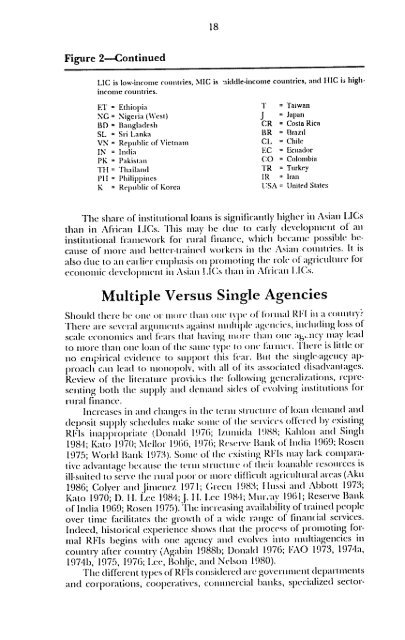I Fiance Apicultural
I Fiance Apicultural
I Fiance Apicultural
You also want an ePaper? Increase the reach of your titles
YUMPU automatically turns print PDFs into web optimized ePapers that Google loves.
Figure 2-Continued<br />
18<br />
LIC is low-income out,,ries, MIC is -,iddle-income countries, and HIC k highincome<br />
countries.<br />
ET = Ethiopia T = Taiwan<br />
NG = Nigeria (West) J = Japan<br />
BD = Bangladesh CR = Costa Rica<br />
SL = Sri Lanka BR = Brazil<br />
VN = Republic of Vietnam CL = Chile<br />
IN = India EC = Ecuador<br />
PK = Pakistani<br />
CO = Colombia<br />
T1 I = Thailand TR = Turkey<br />
Pl = Philippines IR = Iran<br />
K = Republic of Korea USA = United States<br />
The share of institutilonal loans is signitficantly higher ill Asian LICs<br />
than in Africatn 1l1Cs. 'lis may Ibe due to early dcvcloment of an<br />
rural finince, which possible pIlcali beinstitutional<br />
franmework for<br />
cause of mote and better-traitivd workers in the Asian comtliies. It is<br />
aIlso Clic to ai eatlit. eII)l;asis oin)tpiootinlg tle role of agrictilitre for<br />
economic development in Asiati IACs tihtan in African I.LCs.<br />
Multiple Versus Single Agencies<br />
Should there )te oit or tIlo( thati ()tt type of lorial RF[ in a COtllltly?<br />
There aT several atgtitiiettts against muliple ageticies, incluidittg loss of<br />
scal( econlotitis and fears that having tmole than one aktncy itay hea<br />
to ilore thait one loan of, th- saite tyNIe to one fturmorvi. 'ltre is little or<br />
no empirical evidence to sttpport this fear. Bit the sitigle-ageticy apl)roach<br />
cai lead to tttontopolv. with all of its associated disadvantages.<br />
Review of the litierature i)rovidcs til e followitng gelretalizatiois, tepleseliting<br />
1)oth the Sttpply and demand sidcs of evolving istitutions for<br />
rtral finance.<br />
Increascs ill and chatnges itl ihe tllill strlletlti of, loal deimand atnd<br />
deposit supply seChdles tiakeSllti of' tite S(e-vicets offemed by exisling<br />
RFIs inapp,-opriate ()onald 1976; Iittia 1988; Kalilon and Singh<br />
198,1; Kato 1970; Nellor 1966, 1976; Bsrveatik of ndia 1969; Rosen<br />
1975; Worhl Bank 1973). Some of the existing RFIs may lack cottiparative<br />
advanlit age e(anse Ihc ter i stiltC-tll" f)t their loatnable icsollices is<br />
ill-suiteCd to serve the rural poor or more difficuth agriculturl areas (Aku<br />
1986; Colycr andJ.itnttez 1971; Gtecn 1983; I lussi and Abbott 1973;<br />
Kato 1970; I). II. Lee 1984; . 1-1.L.ee 19841; Mur.a 1961; Reserve Bank<br />
of India 1969; Rosen 1975). 'The inicreasitig availability of ttailned people<br />
over" time facilitates the growth of a wide rvnge of finanial services.<br />
Indeed, historical experience shows that the roct'ss of prolnoting formal<br />
RFIs begins with oie agency and evolves into tiuhtiageticics in<br />
country after Colntty (Agabin 19881); Donald 1976; FAO 1973, 1974a,<br />
19741, 1975, 1976; Lee, Bohije, and Nelson 1980).<br />
hI different types of RFIs cot,;idCeeCdmare govertnmienit dCe)arltients<br />
and corporations, cooperaLtives, cotnitircial banks, specialized secto

















